I spent every waking hour (and some that I was having a hard time staying awake!) birding. This included van trips all over the Toledo/Sandusky area, lots of birding on my own (primarily on the Magee Marsh Boardwalk) and a few trips to Ottawa National Wildlife Refuge.

By the end of the nine days I spent there, I saw 144 species of birds (98 less than the festival's total!), of which 13 were Lifers. I managed to get decent photos of 10 of the Lifers plus some photos of birds I hadn’t captured before.
Two of the three I missed – fast-flying Chimney Swifts and a skulking Mourning Warbler – never even gave me a chance for a shot. The American Woodcocks I saw were, well …
Let me explain.
American Woodcock Sky Dancing
The day I arrived, I picked up my registration materials at the Maumee Bay Lodge and Conference Center and then checked into my condo. Then, I visited the Magee Marsh Boardwalk and headed back to Maumee Bay for my first scheduled event, watching the mating ritual of the American Woodcock.
This funny bird is highly secretive, hiding in high grass during the day and coming out at dusk to engage in courtship.
The males wobble out into open spaces and perform display flights at dawn and dusk and, if the light levels are high enough, they also display on moonlit nights. The male's ground call is a short, buzzy peent (some say "meep," but that should be reserved for a Roadrunner). After sounding a series of ground calls, the male takes off and flies from 50 to 100 yards into the air. He descends, zigzagging and banking while singing.
 |
| Display path; Photo: Lake Country Nature |
This high spiraling flight produces a twittering sound as air rushes through the male's outer primary wing feathers.
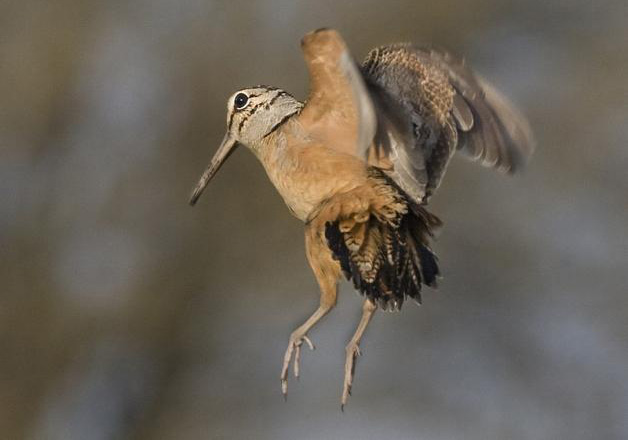 |
| In the air; Photo: BirdNotes |
Females, known as hens, are attracted to the males' displays. A hen will fly in and land on the ground near a singing male. The male courts the female by walking stiff legged and with his wings stretched vertically, and by bobbing and bowing. A male may mate with several females. The male Woodcock plays no role in selecting a nest site, incubating eggs or rearing young. In the primary northern breeding range, the Woodcock may be the earliest ground-nesting species to breed.
Males may continue with their courtship flights for as long as four months, sometimes continuing even after females have already hatched their broods and left the nest.
To see a video about American Woodcocks, click here.
Our guides told us that Woodcocks had been in Maumee since February and that only a few were still there. I took my camera and tripod and ratcheted my ISO up to crazy levels. We did see a few Woodcocks and definitely heard them. I was able to capture one bad image on my cell phone. Even though it was full dark, I continued to shoot photos, even though I could not even see where to focus. One picture actual revealed the bottom half of a Woodcock.
I went back to the area several times and heard the funny buzzy peent, but I never got a good photo.
Home Sweet Home
As I mentioned, I rented a condo about six miles from Magee Marsh.
It turned out to be perfect for accessing the Boardwalk and not too bad for getting to my 6:00 a.m. tour pick-ups (some 20 miles to the west at Maumee and some 14 miles to the east in Port Clinton, Ohio).
It wasn’t fancy, but it had a kitchen and a washer/dryer. The kitchen was a real plus because, despite the fact that 80,000 people visit for spring migration each year, there are very few places to eat in the area. I cooked all my meals and made all my packed lunches for my tours (on days with no tours, I just popped back to the condo for lunch).
 |
| My condo in Sand Beach |
The only times I ate out were the banquet and getting an orange sherbet/vanilla cream soft-serve twist at the Barnside Creamery, a BWIAB “must visit” that had a line every time I passed it. And, since it was on my route to practically everywhere, I passed it a lot.
 |
| OK, so there was no line at 5:30 a.m.! |
I heard there was a place where one was supposed to get a piece of pie after seeing a lifer, but I never made it there. For the most part, I didn’t want to take time away from birding to eat, so the condo was perfect. And, I certainly didn't need 13 pieces of pie!
Yeah, my condo did have a view of the nearby Davis–Besse Nuclear Power Station.
 |
| Well, there's that! |
Black Swamp Bird Observatory
The BWIAB sponsor is the Black Swamp Bird Observatory (BSBO), an organization devoted to inspiring the appreciation, enjoyment and conservation of birds and their habitats through research, education, and outreach.
 |
| BSBO changed its logo and revealed the new one, right, at the BWIAB |
BSBO was founded in 1992 by a group of biologists studying bird migration. Having collected several years of data, they recognized the need for an organization to help disseminate their research findings. BSBO's long-term research projects have helped to develop a greater understanding of bird migration and the habitat needs of Songbirds, Raptors, Shorebirds and Rails.
 |
| King Rail banding |
BSBO data has been used to assist both private and governmental land owners in better managing their properties for migratory bird species.
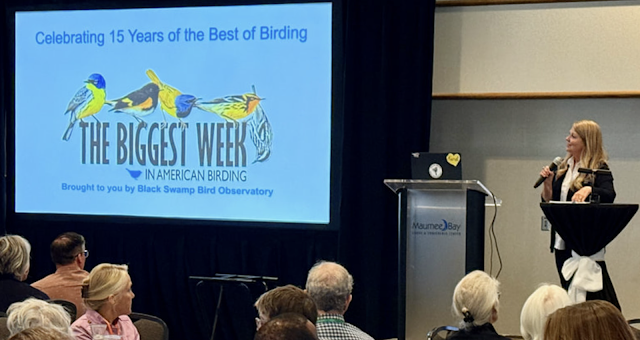 |
| BSBO Executive Director Kim Kaufman speaking at the BWIAB banquet |
The Observatory's education and outreach programs have a strong focus on youth education including the Wetland Investigation Network (WIN) program, which offers students grades K-12 a day-long exploration of the entire marsh ecosystem, and the Ohio Young Birders Club.
BSBO developed the Birds and Business Alliance program to raise awareness among local businesses of birding tourism in the area and to provide business owners with information on providing quality services for the birding audience. BWIAB has brought more than $40 million into the local economy.
FYI: the marshes in northwestern Ohio were once called the Black Swamp.
Magee Marsh Boardwalk
I spent a lot (a lot!!!) of time on the Magee Marsh Boardwalk.
The first morning I went, which was the Saturday before Mother’s Day, was so crowded that I had to leave.
I was concerned that it would be awful trying to fight the crowds for the whole week, but that was – by far – the worst it ever was. Sometimes, it was even almost empty. That was the advantage of staying close, I could hang at the Boardwalk until sundown.
 |
| Crowd size varied; sometimes it was virtually deserted |
The Boardwalk passes part of the Magee Marsh Wildlife Area on Lake Erie. The marshes here gained fame during the late 1800s as some of the best waterfowl hunting areas in the US.
 |
| Magee Marsh |
Wealthy sportsmen vied to purchase choice hunting sites and, as early as 1890, much of the wetland area was being operated for private shooting. By the mid-1900s, the entire 30,000 acres of remaining marshland along Lake Erie, from Toledo to Sandusky, was under private club ownership. Today, the region still supports some of the most intensively developed and managed waterfowling clubs in the Midwest.
 |
| Weather vane at Winous Point |
I birded at the site of one of those clubs during the festival. Winous Point Marsh Conservancy is located on what used to be an exclusive hunting club.
But, back to Magee: Purchased by the Ohio Division of Wildlife in August 1951, Magee Marsh Wildlife Area lies in some of Ohio's finest remaining wetlands.
During the 1960s, a small flock of Canada Geese was released and Goose nesting tubs were erected at Magee Marsh as part of Ohio's Canada Goose reintroduction program (really!).
 |
| Canada Goose families along Magee Marsh's entrance road |
I promised I wouldn’t do a blow-by-blow of what birds I saw where, but I did see most of my Warblers on the Boardwalk, including my one encounter with a Golden-winged Warbler.
 |
| A pretty bird |
I saw a Green Heron nest in a big tree hanging over a marshy lake along the route.
 |
| Although known to many birders, I spotted this one myself |
I took lots of photos of the nest, but the only differences day-to-day were of how the patient Heron incubating her brood was sitting.
 |
| This day she was easy to see |
I, and lots of fellow birders, were fortunate to be able to watch a female Prothonotary Warbler building a nest in a hollow log right by the Boardwalk.
 |
| It was fun to watch this diligent bird |
And, I was lucky to see a Black-billed Cuckoo, after one failed attempt where I actually got down on my knees to try a see from a difficult angle.
 |
| A Lifer for me! |
And, the Boardwalk yielded several raptors and nightjars …
 |
| A Bald Eagle nest … |
 |
| An Eastern Screech Owl ... |
 |
| Two Common Nighthawks |
And, a big treat was a first look at an Eastern Whip-poor-will ...
 |
| I heard so many growing up in Florida, but I had never seen one! |
My first afternoon at the Boardwalk, I made my other big mistake. I heard that they were seeing a Kirtland’s Warbler on the Estuary Trail. I had just gotten there. I hadn’t even fully unloaded my car or bought groceries. I didn’t know where the Estuary Trail was. I decided not to try to find it, figuring I’d have a chance the next morning. Nope! That was it for the extremely rare Kirtland’s. I knew better.
And, the Estuary Trail (full name: Crane Creek Estuary Trail) was right next to the Boardwalk. Major fail!
 |
| Lake Erie on the way to the Crane Creek Estuary Trail |
Although, I did hear the crowd looking at the Kirtland’s was so big that it was hard to catch a glimpse. Still, major Fail!
Before I continue, I want to talk a bit about photography.
I already mentioned how impossible it was to get a decent shot of an American Woodcock. I can tell you that a lot of this photography was tough: dense foliage, lots of twigs, dark shadows, fast birds, distant birds, skulking birds, birds that were downright hiding. So, I came home with ...
But, I did manage to get some pretty good photos. Let’s start looking at some in the next post!









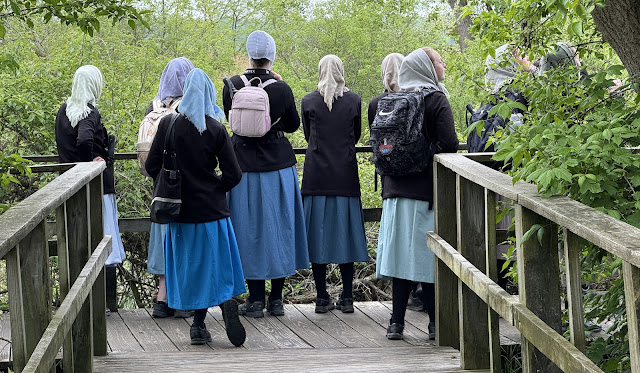








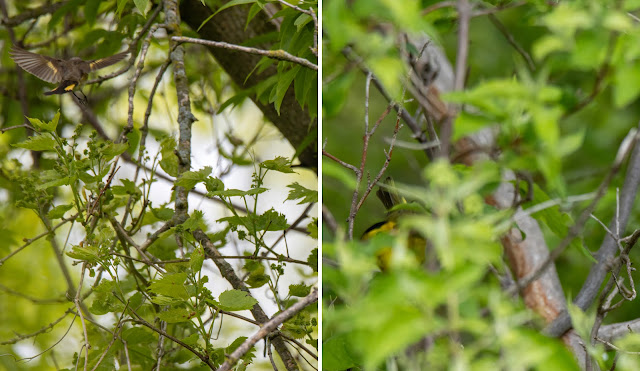
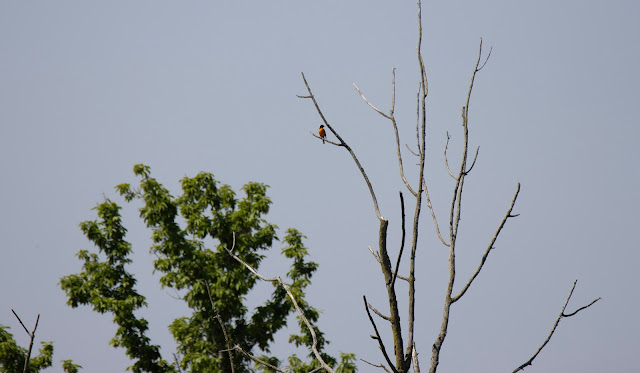




No comments:
Post a Comment